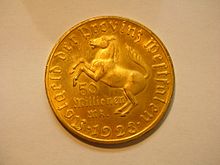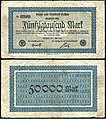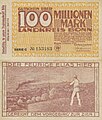Emergency money
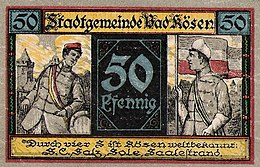
Emergency money is a money substitute that has arisen from a shortage, replaces missing legal tender and is issued by states, municipalities or private companies.
Function and appearance
In times of war and crisis, trust in emergency money is often greater than in official money. It is issued in domestic, foreign or historical currency ( gold marks , US dollars ), but also as a claim to goods such as grain, sugar or wood. In addition to the usual forms of money, coins ( emergency coins ) and bank notes , various substitute materials such as porcelain , cardboard , leather , pressed charcoal , silk or linen have also been used. In 1923, for example, the newly founded aluminum rolling mills in Teningen and Singen issued emergency bills made of printed aluminum foil . Even Stamps (about as encased postage ), playing cards , checks and similar documents are converted into emergency money. Which objects are assigned a value as emergency money can be very diverse and sometimes also very regionally. Emergency money is only used as a means of payment, not for credit purposes.
history
Siege tickets

The oldest forms of emergency money are siege notes. A supply of money was often impossible during the siege of cities. Therefore, siege certificates were often issued by the city administration, more often by the respective military commanders. The first siege certificates are those from the time of the siege of the Spanish fortress of Alhama by the Moors in 1483.
The issue of emergency money became more common at the end of the 18th century. Now there was also revaluation of existing paper money as emergency money. In 1793 General Adam-Philippe de Custine was besieged in Mainz by coalition troops under General Friedrich Adolf Graf von Kalckreuth . As emergency money, French assignats were upgraded with handwritten additions and stamps on the unprinted back in order to increase the amount of money. When this was not enough, own assignats were printed. During the Second Boer War , shirt money was put into circulation.
These siege certificates often bear the original signatures of the respective commander. The redemption of the notes typically depended on the outcome of the war. If the siege was successful - and the war was lost - the redemption of the notes was not to be expected.
Siege Coins
Siege coins were used similar to siege tickets. These were made of metal, but also other materials, to serve as a means of payment , mostly to pay the troops.
In 1574, in Leyden, besieged by the Spaniards, the mint stamps were struck on cardboard (the covers of Catholic church registers) instead of precious metal, thereby creating cardboard coins as emergency money. This is the oldest surviving emergency money in the world.
Tyrolean fight for freedom
Andreas-Hofer-Kreuzer , also called Hofer-Kreuzer, are 20 and 1 Kreuzer pieces minted in Hall in Tyrol during the Tyrolean struggle for freedom in 1809 , which are also known as emergency money. The front shows the Tyrolean eagle and the inscription “Gefürstete Grafschaft Tirol”, the reverse shows the value. The 20-Kreuzer piece is referred to as the Sandwirt's Twenties. The silver for minting the 20 Kreuzer pieces came from the Brixlegger smelter and from purchases. Even expendable church silver should be used for minting coins.
First World War and the interwar period
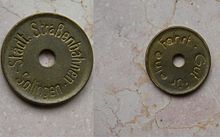
At the beginning of the First World War, 1914 emergency banknotes were the first to be issued in East Prussia. Many other issues followed throughout the German Reich in 1914/15.
A particularly large amount of emergency money was issued in the German Reich during and after the First World War and during the hyperinflation of 1923 . The hoarding of silver coins (due to inflation, their material value was higher than their face value ) and the metal requirements of the war industry led to a shortage of change. State banks, cities, municipalities, districts and private companies jumped into the gap and covered the need with their own expenditure, "transport expenditure" intended for the circulation of money.
The expenditure initially used as emergency money developed more and more into a speculative business. The 1 billion mark piece from the Province of Westphalia from 1923, the coin with the highest face value during the period of inflation, had already been devalued by hyperinflation at the time of its planned issue. The coin could therefore only be sold as a souvenir after the inflation in 1924.
The large number of varied banknotes with a lot of local flavor also aroused the interest of collectors, which led to the fact that many emergency banknotes were no longer printed and issued for circulation, but specifically for collectors. Such notes are called serial notes .
The German emergency money of the First World War can be divided into two periods: the first period of the small denominations up to around 20 marks around 1916 to 1919 and the second period from around 1921 with high denominations up to the trillion marks. In addition, in the summer of 1923 there were dollar and gold mark denominations as “emergency money of stable value”, or treasury notes . For a while, coupons from war bonds were still in circulation around 1918.
In Austria , the city of Innsbruck began issuing emergency money in the summer of 1919 in order to remedy the shortage of change. Kitzbühel and Kufstein followed in September , then parishes in Vorarlberg and Salzburg before it was extended to all of Austria. In Vienna, on October 28th, the municipal council decided to issue “receipts”. In the federal state of Upper Austria , emergency money was issued in most municipalities during 1920. The provincial capital Linz issued the first official on March 3, 1920, followed by the federal state on April 13, after the emergency money had been in circulation since autumn 1919 due to the lack of change. In the course of the year, 425 of 503 municipalities issued emergency money. Emergency money was in circulation until October 1, 1921, when it was no longer valid. Even before that, the hyperinflation at the time meant that the smallest amounts were no longer needed. The notes were often made by well-known artists such as Klemens Brosch , Wilhelm Dachauer , Ludwig Haase jun. , Max Kislinger and Anton Lutz designed what also spurred the joy of collecting back then.
The Liechtenstein emergency money was a temporary solution in the Principality of Liechtenstein between the termination of the tax and customs treaty with Austria in 1919 and the entry into force of the customs treaty with Switzerland. It replaced the Austrian crown and was in turn replaced by the Swiss franc .
After the Second World War
Germany
Between the Second World War and the currency reform in 1948, cigarettes were considered an unofficial means of payment in Germany . The units were a packet or a stick.
During the currency reform in the German western zones in 1948 , the new currency Deutsche Mark was initially only issued in banknotes (smallest denomination: 1/2 DM or 50 Pfennig), as small change the Reichsmark small coins up to 1, - ℛℳ remained at a tenth of the face value currently valid.
Due to the currency reform in the western zones, the "eastern zone" was forced to put Reichsmark cash out of circulation as quickly as possible; But since no new banknotes were available at such short notice, existing Reichsmark banknotes with tokens on them had to serve as replacements for the time being. These banknotes were popularly called koupon marks or glue marks . The small Reichsmark coins initially remained valid at face value.
With the monetary, economic and social union on July 1, 1990, the German mark ("Westgeld") also became an official means of payment in the GDR . Since not enough change could be made available at first, the GDR small coins of up to 50 pfennigs remained valid for one year at face value (although after reunification only in the "accession area").
Other countries
From 1975 to 1979 there was a coin shortage in Italy ; regional banks and trading companies in Italy and San Marino issued so-called miniassegni as emergency money . However, acceptance was regionally limited. Assegno is the Italian word for statement or check. According to the “Regio Decreto Legge No. 2283 of October 7, 1923 - Disposizione sull Assegno Bancario e circolare che vanno dagli art. 82 al 86 “in Italy banks are allowed to circulate assegno circulare that can be used like cash. However, the equivalent value must be deposited in full at the state bank, so that no money is created with this issue . This instrument was used extensively from 1943 to 1945 and 1966 after the 500 lira coin containing silver was abolished.
At the height of the Argentine economic crisis in 2001/02, insolvent provincial governments paid their officials, employees and service providers with so-called patacones , i.e. H. Debt securities that should be redeemable at a later date for regular Argentine pesos.
Other forms
Similar to emergency money is what is known as camp money , which prisoners of war receive instead of regular money. In the form of ghetto money or the camp money from the concentration camps , these forms of replacement money were used under National Socialism to plunder and deprive prisoners of their rights.
gallery
Bielefeld
KreissparkasseKiel
city main officeMönchengladbach
Chamber of CommerceWörth an der Donau
Castle Pharmacy
See also
literature
- Ingrid Bubeck: Lack of money and emergency money in Thuringia. 1st edition. Sutton, Erfurt 2007, ISBN 978-3-86680-149-3 .
- Anton Geiger: German emergency money. Volume 3: The German large emergency money 1918–1921 (catalog of all emergency money notes with a face value of 1 to 100 marks). 2nd Edition. Gietl, Regenstauf 2003, ISBN 3-924861-79-X .
- Wilfried Gerke : Born in Nottiet ... Notgeld told. Our home on money. Ed .: Kreissparkasse Grafschaft Diepholz. Diepholz 1992, OCLC 75350128 .
- Hans L. Grabowski: The paper money of the German states from 1871 to 1948 - The banknotes and emergency notes of the German states, provinces and districts. 1st edition. Gietl, Regenstauf 1999, ISBN 3-924861-33-1 .
- Hans L. Grabowski: German emergency money. Volume 9: Emergency money of a special kind - banknotes made of fabric, leather and other unusual materials. 1st edition. Gietl, Regenstauf 2005, ISBN 3-924861-93-5 .
- Hans L. Grabowski: German emergency money. Volume 5/6: German small change notes: Official traffic issues 1916–1922 . 2 volumes. 1st edition. Gietl, Regenstauf 2004, ISBN 3-924861-85-4 .
- Hans L. Grabowski, Manfred Mehl: German emergency money. Volume 1/2: German serial tickets 1918–1922 . 2 volumes. 2nd Edition. 2003, Regenstauf: Gietl, ISBN 3-924861-70-6 .
- Hans L. Grabowski, Wolfgang J. Mehlhausen: Handbuch Geldscheinsammeln - A guide for banknote collectors and those who want to become one. 1st edition. Gietl, Regenstauf 2004, ISBN 3-924861-90-0 .
- Hans Hagen Hottenroth: Emergency money in Lower Austria. A commandment of bitter need. 1st edition. Lower Austrian Press House, St. Pölten 1980, ISBN 3-85326-603-7 .
- Klaus-Jürgen Karpinski East Prussian paper money. Self-published, 2007, ISBN 978-3-00-021060-0 .
- Arnold Keller: German emergency money. Volume 7/8: The emergency money of the German inflation 1923 . 2 volumes. Gietl, Regenstauf 2004, ISBN 3-924861-86-2 .
- Manfred Müller: German emergency money. Volume 4: The emergency notes of the German inflation 1922 (from August 1922 to June 1923). 2nd Edition. Gietl, Regenstauf 2003, ISBN 3-924861-80-3 .
- Prange, Gustav: The German emergency money. A cultural-historical description. Volume I, 2nd edition. 1921; Volume II, 2nd edition. 1922. Publishing house Görlitzer Nachrichten u. Indicator. (Reprint of the 2nd edition: kolme k-Verlag, 1996, ISBN 3-927828-42-4 )
(on the shortage of coins in Italy 1975–1979 :)
- Hans Magnus Enzensberger: Oh, Europe! 6th edition. 1998, ISBN 3-518-04432-X .
Web links
- Curious emergency money. (accessed on February 10, 2013)
- Emergency money. The beautiful sparkle. ( Memento of September 17, 2008 in the Internet Archive ) (accessed February 10, 2013)
- Emergency money. In: Historical Lexicon of Bavaria (accessed on February 10, 2013)
- Emergency money in Bavaria 1914-1923 in bavarikon.de
Individual evidence
- ↑ Helmut Kahnt, Bernd Knorr: Old dimensions, coins and weights. A lexicon. Bibliographisches Institut, Leipzig 1986, licensed edition Mannheim / Vienna / Zurich 1987, ISBN 3-411-02148-9 , p. 393.
- ↑ porcelain and Keramiknotgeld
- ^ Albert Pick: Paper money. 1967, pp. 43-45.
- ↑ Heinz Fengler,…: transpress-Lexikon numismatics. (1976), p. 19
- ↑ Friedrich von Schrötter , ...: Dictionary of Coin Studies , p. 27.
- ^ Siegfried Bauer: German coins 1871 to 1932 including the coins of the former colonies and the state emergency money. Berlin 1976, p. 93.
- ↑ Rudolf Wilhelmy: History of the German emergency money of stable value from 1923/1924. Dissertation . FU, Berlin 1962.
- ^ The Vienna city money. In: Neuigkeits-Welt-Blatt , October 31, 1918, p. 7 (online at ANNO ).
- ^ Emil Puffer: Emergency money in Upper Austria. The shortage of change in 1919/20 and its elimination. In: Upper Austrian homeland sheets . Year 32, Linz 1978, Issue 1/2, pp. 103–111, online (PDF; 933 kB) in the OoeGeschichte.at forum.
- ^ Message from the Federal Minister of Finance (PDF; 20 kB) Juris: Laws on the Internet, accessed Nov. 10, 2011, 9:15 pm.
- ↑ Werner steel: assegni, assegni. In: Monetary History News. No. 64, March 1978, pp. 61-66.


